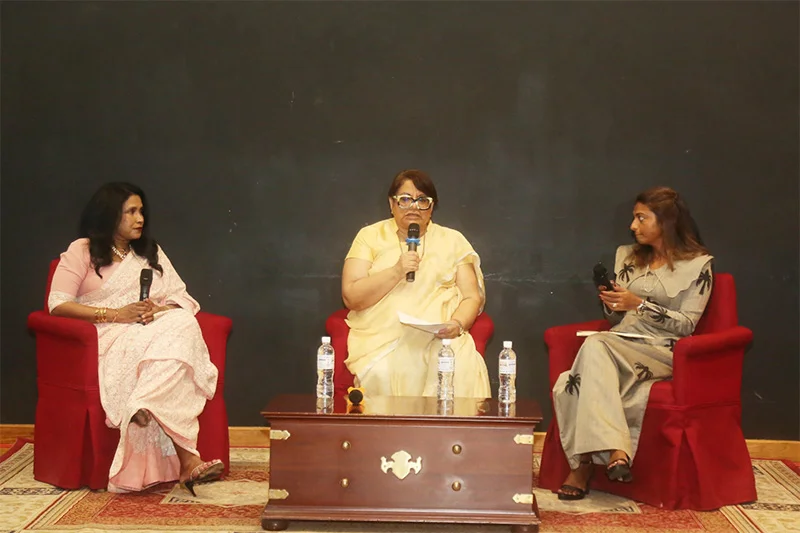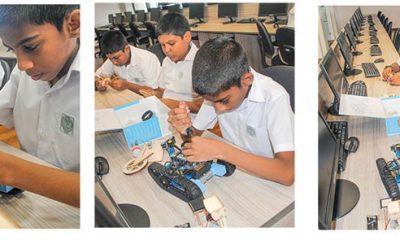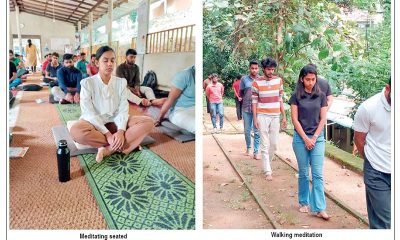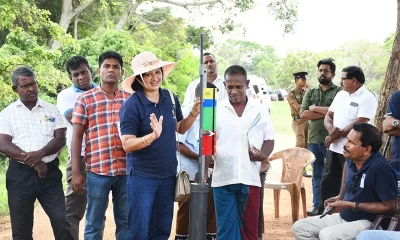Features
New Normal Sleep Pattern – Segmented Sleep

“And the night coming on, we will lead you to their Bed Chambers and shew you how they sleep. About which they are not very curious….They are so little given to sleep, that they do rise many times in the night and eat Betel and take Tobacco. Which done they lay them down and sing songs until they fall asleep again.”
That’s Robert Knox (1641 – 1720) in his An historical relation of Ceylon giving us info on how the villagers and even higher ups in Eladetta, the Kandyan village of his house imprisonment, slept at night or kept awake. He was lured to the Kandyan kingdom when his father’s trading ship was wrecked and the sailors landed in Lanka. This was during the reign of Rajasinghe II of the Kandyan Kingdom who had a penchant for keeping prisoner many a white person, One is never sure however, when reading Knox, whether he is reporting accurately or stretching a point or two with tongue in cheek.
I am surprised he did not say the villagers were un-industrious and given to much sleep during daytime too, since in those parts of the island, being blessed with even climatic conditions, food was plentiful with the least amount of time and energy expended on its production.
New Theory – segmented sleep
A recent article I read quoted professor of history, A. Roger Ekirch at Virginia Tech., who noted that in the Middle Ages and through the early 19th C, a sleep cycle believed to be standard in multiple cultures was ‘segmented sleep’ which meant that people went early to bed, probably at sundown and woke three to four hours later. They did not toss around in frustration; rather did they awaken and socialize, read books, had small meals, made love and then went back for a second sleep for another four hours. It was only when artificial light was available widely that people forced themselves to sleep through the night,
 Professor Ekirch, who has studied segmented sleep for the past 35 years, said there are more than 2,000 references to it from literary sources: everything from letters to diaries to court records to newspapers, plays, novels and poetry, from Homer to Chaucer to Dickens.
Professor Ekirch, who has studied segmented sleep for the past 35 years, said there are more than 2,000 references to it from literary sources: everything from letters to diaries to court records to newspapers, plays, novels and poetry, from Homer to Chaucer to Dickens.
I add that maybe in our Island of today, people may resort to segmented sleep – go to bed and actually sleep when power cuts are on as they seem to be at peak time of electricity use between 6.00 and 9.00 pm.
How it was in our childhood
We had to keep in mind the slogan ‘Early to bed and early to rise, makes a man healthy, wealthy and wise.’ This of course had a corollary maxim: ‘Satan finds evil for idle hands’ so once homework and dinner were over – off went the kids to bed. We could of course sleep the moment innocent heads touched kapu pullung home made pillows. Equally certain were nightmares and shouting at night.
Never forgotten were incidents when I was in the Hillwood College Middlewood Hostel (pre-teens but not the very young) for a year. The Upper Lake Road, sinister even in daytime, was just above the dormitory. One girl would shout and then a chorus of screaming voices. I remember clearly I did not know the reason for the screaming that woke me up but joined the chorus lustily. Maybe the ulterior aim of the wicked kids was to see Miss Rat appear from her room in her skimpy see-through nightie silhouetted against the night light!
You still have the battle of the rigid bed time, epitomized by cartoon strip Calvin when he is sent to bed at the correct time according to his long suffering parents but far too early for him and Hobbes who want to watch TV comics or more likely, create renewed mayhem.
Remembered also is my maternal grandmother’s segmented sleep pattern. When sent on short holidays to the Mahagedera in Boyagama, Peradeniya, my sister and I would decide to pull a mattress into the pantry to sleep close to Aththa who seemed to abhor bedrooms. Grandfather slept in splendor in the huge curtained double bed. She deserted it no sooner the family of many children was complete. She opted to sleep close to the kitchen with its ever smouldering fireplace of rice husks over which hung permanently a kettle for instant hot water. Aththa would suddenly shout “Kelle, pol gediyak vatuna’ to the little servant girl asleep near her, and identify the place accurately – bona watura linda lange; pan watte, enasal kele. We loved it but had to suppress our bursting laughter in case the Brownie points gained by sleeping on the ground near her were cancelled out by our laughing at her.
Changes
Benjamin Reiss, a professor of English at Emory University and the author of ‘Wild Nights: How Taming Sleep Created Our Restless World’ has said that rather than sleep broken into segments being a choice at the time, it was simply something that people did, as it fit agricultural and artisanal patterns of labor.
Everything changed with the Industrial Revolution, emphasizing profit and productivity; with the belief that people who confined their sleep to a single interval gained an advantage. The growing prevalence of artificial lights permitted later bedtimes, leading to sleep compression.

And now
“Thirty percent of people report waking up with sleeplessness at least three nights per week, according to one study published in 2010 in the Journal of Psychosomatic Research, and 25 percent of adults suffer from insomnia each year, according to a recent study by researchers at the University of Pennsylvania. For some people, the pandemic has spurred more flexible schedules, which has led to experiments with the old-fashioned sleep method.”
Here is the reported case of a 52-year-old finance manager. In the last 20 years, he didn’t remember a time when he slept completely through the night. “I always woke up halfway through the night and just lay there,” he said. “Physically, I wanted to get up, but I needed more sleep.”
So in August 2021, he started segmented sleeping, going to bed at 10 p.m. and waking up naturally at 2 a.m. He gets up for one and a half to two hours to read and to pray. Then he goes back to bed around 3:30 or 4 a.m. and sleeps until his wife wakes him at 6:30 or 7 a.m.
“This is what my body was trying to do, even when I had never heard of segmented sleep,” he said. “I finally got to a place where I have a healthy sleep pattern.”
Oldies have the added problem of wanting to visit the toilet at least once or twice in the night. Most get back to sleep easily, but once in a while, if the mind is stressed, often over trivia, sleep proves elusive. The best remedy then, instead of tossing and turning and cursing, is to switch on the bedside light and read, or much better, sit up in the dark and meditate or just sit in reflection. A calmed mind is a mind ready to go to deep sleep.
Less of a heavy dinner too helps in continuous sleep. I remember the excellent sleep enjoyed and benefited when at Dhamma Kuta, Hindagala, meditation retreats. A tumbler of fruit juice or tea at 5.30 pm and nothing else but cool water and I slept so well to wake up bright at 4.00 am. Those taking medicines were offered biscuits and a plantain in the evening.
New work schedules
Working from home and left to one’s own time tables, it is noted that some have reverted to the practice of segmented sleep. It may be a consequence of stress induced by the fears and restrictions of the pandemic.
So are we simply reverting to our long forgotten, natural sleep cycle? And could this be the cure for those deemed middle-of-the-night insomniacs? It is reported that doctors are conflicted about how healthy segmented sleep is.
Robert Knox for 19 years starting in 1658 recorded every habit and nuance of behaviour of the Sinhalese villager of the Kandyan Kingdom. Using oil lamps and torches made from dried coconut leaves (hulu athu), naturally had them resorting to segmented sleep patterns, which he
recorded in his An Historical……
Features
How a Feminist Foreign Policy could lay the basis for a more peaceful world

 Looking at foreign policy questions from a feminist viewpoint may strike many in even the world of democracy as quite a new approach to studying external policy issues but this perspective has been around for quite some time and it would be in the interest of states and publics to take profound cognizance of it. This is in view of the implications of the perspective for international peace and stability.
Looking at foreign policy questions from a feminist viewpoint may strike many in even the world of democracy as quite a new approach to studying external policy issues but this perspective has been around for quite some time and it would be in the interest of states and publics to take profound cognizance of it. This is in view of the implications of the perspective for international peace and stability.
Given this backdrop, it was in the fitness of things for the Bandaranaike Centre for International Studies (BCIS) Colombo, a major pioneer in the teaching and researching of International Relations in Sri Lanka, to set off special time to introduce and discuss Feminist Foreign Policy (FFP) recently. The relevant symposium was the final one in a series of forums of importance to foreign and domestic policy issues the BCIS conducted in the course of November this year to celebrate the 50th anniversary of its founding.
Titled ‘Leadership for Peace and Feminist Foreign Policy’, the forum was held on December 9th at the BMICH’s ‘Mihilaka Madura’ under the aegis of the BCIS, headed by the latter’s Executive Director Priyanthi Fernando. Prominent among the members of the audience at the symposium was the Chairperson of the BCIS, former President Chandrika Bandaranaike Kumaratunga.
The panelists at the forum were Prof. Rangita de Silva de Alwis, Associate Dean of International Affairs, University of Pennsylvania Law School, USA and an Expert Member on the CEDAW and Eva Abdullah, Chairperson, Maldives Policy Think Tank and a former Deputy Speaker of the People’s Majlis of the Maldives. The symposium was moderated by Dr. Radhika Coomaraswamy, former UN Under-Secretary General and Special Representative of the Secretary General on Children and Armed Conflict (2006-2012).
Prof. Rangita de Silva, among other things, pointed to the importance of re-imagining FFP and making it increasingly relevant in the formulation of a country’s foreign policy. She said that going forward, foreign policy will need to be increasingly based on a feminist perspective and there are some major countries of the South and North that have already given their external policies this orientation. It was pointed out that by 2025, France, for example, would be taking this policy direction; that is, the best interests of France’s women would be taken into consideration in the formulation and implementation of foreign policy.
Chile, the same speaker pointed out, a major country of the South, is in the forefront of integrating or merging its domestic and foreign policies with a view to prioritizing the legitimate interests of women in the crafting of its external policy.
Eva Abdullah pointed to the crucial contribution women make to a country’s economy. Women in the Maldives, she said, work 19 hours a day. She cogently elaborated that economic instability is a chief causative factor in the disruption of peace and stability in a country, in view of its subtle capability to undermine a country’s material wellbeing. The latter, in turn, causes social disaffection and unrest. But, generally, the factors seen as undermining a country’s peace are physical conflict and war; that is, overt violence.
However, it is important to come to grips with the less visible or more subtle destroyer of peace, which is economic instability. This form of instability, it was pointed out, has grave long term consequences. For instance, a country’s economic ruin is virtually inherited by every new born infant, since a country in debt is obliged to repay such loans and it falls to future generations to do so.
Abdullah went on to elaborate that economic austerity measures undertaken by a country in debt, for example, while disruptive of peace, exert a deleterious impact on particularly women and other vulnerable groups. After all, the contribution of women to the GDP of a country is inestimable. This is all the reason why women’s issues need to be brought to the forefront of foreign policymaking.
In other words, foreign policy, Abdullah pointed out, is essentially all about the promotion of human rights. Since such rights are insidiously undermined during times of economic austerity; debt issues, which come to the fore during economic crises in particularly the South, cannot be viewed in isolation from women’s issues and external policy.
Thus, the forum raised issues of crucial importance to foreign policy formulation which countries of the South in particular need to take into account very seriously, going forward. At the end of the symposium a Q&A followed where many an issue of relevance was taken up for discussion.
It ought to be clear to the unbiased observer and commentator that a feminist perspective in foreign policy is of crucial significance to the process referred to as democratic development. The latter signifies growth in tandem with redistributive justice. It goes without saying that foreign and domestic policies that do not help in furthering these aims serve no useful purpose. Thus, a feminist foreign policy and its underlying principles cannot be glossed over or ignored in the process of external policy formulation and implementation.
Generally, a woman’s contribution to a country’s GNP and overall wellbeing goes largely undocumented and unappreciated. For example, women work selflessly and silently in their homestead, but no official price tag is attached to such labour which is instrumental in ‘keeping the home fires burning’. Accordingly, the panelists’ observation that foreign policy in the real and feminist sense is essentially all about the promotion of human rights amounts to an insight of great worth.
Features
A star in the making…

 Most of us are familiar with the name Don Sherman, from Melbourne, Australia, who is also known as the ‘Singing Chef,’ but I doubt Sri Lankans here are aware that he also has a pretty daughter – Emma Shanaya.
Most of us are familiar with the name Don Sherman, from Melbourne, Australia, who is also known as the ‘Singing Chef,’ but I doubt Sri Lankans here are aware that he also has a pretty daughter – Emma Shanaya.
What’s extra special about Emma is that she is following in her father’s footsteps – not as a Chef, but as a singer!
Reports coming my way indicate that Emma, born in Sri Lanka, is an emerging singer-songwriter from Melbourne…known for her soulful voice and heartfelt lyrics.
Growing up, Emma was exposed to the world of music through her father, Don Sherman, who is still a very popular personality, in Melbourne, while her brother Shenan is a pianist in a band.
At 14, they say, Emma discovered her passion for music and has been honing her craft ever since…performing at special events, parties, etc.
This extremely talented artiste released her debut original, on December 1st, 2024 – “You Made Me Feel,” a song she wrote and performed herself, with mixing and mastering by Markia Productions.
The accompanying music video, produced by Synapse Productions, is now live on YouTube and music lovers could check it out – Emma Shanaya. Her other socials are:
Instagram: @emmashanaya
Facebook: Emma Shanaya
TikTok: Emma Shanaya
Emma trains at the renowned Andrea Marr Music School, in Melbourne, and Andrea’s coaching has been appreciated by many who consider her teaching method as a boom to their career as performers.
In fact, another singer of repute in Melbourne, Derrick Junkeer, who was in Colombo last December and performed at the All-4-One concert, was very impressed with Emma’s singing and says she is poised for a promising career in the music industry.
Yes, Emma Shanaya is certainly on the right track to hit the big time in the music industry and says she has plans to create many more originals and also integrate her Sri Lankan culture into her music.
“I hope to write and make more music and be a performing artiste in Melbourne and Sri Lanka. I want to include my Sri Lankan culture and language into my music.”
In addition to singing, she loves dancing and acting and has done a few acting and model projects as well.
Emma graduated from Deakin University, in September 2024, with a Bachelor of Business and Bachelor of Arts (majoring in drama) and is currently working full time as a kindergarten teacher in a Montessori in Melbourne.
The star in the making is in Sri Lanka, at the moment, on holiday, and says she loves the scene here.
“Sri Lanka is great! Has become a lot more pricier but the tropical lifestyle and vibes are unmatched.”
Emma will be flying back to Melbourne on Christmas Day and will be joining her parents for some celebrations later during the day.
“I take this opportunity to wish The Island readers a Very Happy and a Peaceful Christmas and I also wish all of you a Wonderful New Year, filled with love and laughter.”
Features
Face Packs to Beat the Heat

 I’m glad The Island readers liked my Beauty Tips last week – Beat the Heat – and requested for a few more Face Packs to Beat the Heat. Okay, here are a few more very cool homemade face packs:
I’m glad The Island readers liked my Beauty Tips last week – Beat the Heat – and requested for a few more Face Packs to Beat the Heat. Okay, here are a few more very cool homemade face packs:
* Mango Face Pack: In a bowl, add one tablespoon of fresh mango pulp. To this add one tablespoon of cold cream and one tablespoon of cold milk. Whip the ingredients well to form a thick paste. When done apply this paste on the skin, allow it to dry and then rinse it off.
* Watermelon Face Pack: In a bowl, add half a cup of watermelon pulp. To this add 01 tablespoon of curd. Combine the ingredients and apply the pack on your face. When the pack turns dry, rinse it off with cold water.
* Curd Face Pack: When curd is used on the skin, it will help to improve the skin tone. Apply cold curd on your face and neck twice in a week…when the heat is on. The curd will open your pores and help you to get a natural glow in no time.
* Cucumber Face Pack: Cucumber is the best vegetable that you can use on the skin in the heat. Make a thick juice out of one cucumber, and 03 tablespoons of sugar with 01 teaspoon of curd. When this pack is ready, massage it on to the skin and let it dry. After 15 minutes, peel the face pack from the skin and then rinse with cold milk.
* Pineapple Face Pack: Grind the flesh of one pineapple to a thick juice. Rinse your face with this juice and let it dry. After 10 minutes, rinse your face with rose water and wipe dry. Wait 15 minutes and then wash your face with cold water. This face pack will make you feel refreshed.
-

 Opinion3 days ago
Opinion3 days agoDegree is not a title!
-

 Features6 days ago
Features6 days agoEmpowering the next generation: St. Benedict’s College brings STEM education to life
-

 Features4 days ago
Features4 days agoSpiritual Awakening of a Village
-

 News2 days ago
News2 days agoInnovative water management techniques revolutionising paddy cultivation in Lanka
-

 News5 days ago
News5 days agoOver 300,000 Sri Lankans leave for overseas jobs this year
-

 Latest News5 days ago
Latest News5 days agoIndia’s Gukesh beats China’s Ding to become youngest chess world champion
-

 Features4 days ago
Features4 days agoRevisiting the role of education in shaping shared futures
-

 Features4 days ago
Features4 days agoThe Silence of the Speaker and other matters











